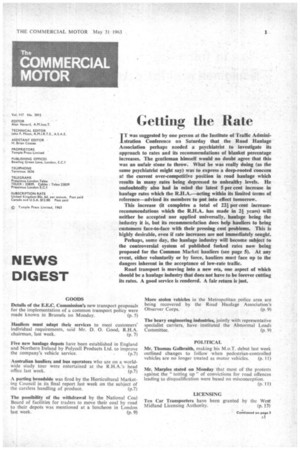Getting the Rate
Page 3

If you've noticed an error in this article please click here to report it so we can fix it.
IT was suggested by one person at the Institute of Traffic AdminiIstration Conference on Saturday that the Road Haulage Association perhaps needed a psychiatrist to investigate its approach to rates and its recommendations of blanket percentage increases. The gentleman himself would no doubt agree that this was an unfair stone to throw. What he was really doing (as the same psychiatrist might say) was to express a deep-rooted concern at the current over-competitive position in road haulage which results in many rates being depressed to unhealthy levels. He undoubtedly also had in mind the latest 5 per cent increase in haulage rates which the R.H.A.—acting within its limited terms of reference—advised its members to put into effect tomorrow.
This increase (it completes a total of 224 per cent increaserecommendations which the R.H.A. has made in 23 years) will neither be accepted nor applied universally, haulage being the industry it is, but its recommendation does help hauliers to bring customers face-to-face with their pressing cost problems. This is highly desirable, even if rate increases are not immediately sought.
Perhaps, some day, the haulage industry will become subject to the controversial system of published forked rates now being proposed for the Common Market hauliers (see page 5). At any event, either voluntarily or by force, hauliers must face up to the dangers inherent in the acceptance of low-rate traffic.
Road transport is moving into a new era, one aspect of which should be a haulage industry that does not have to be forever cutting its rates. A good service is rendered. A fair return is just.












































































































